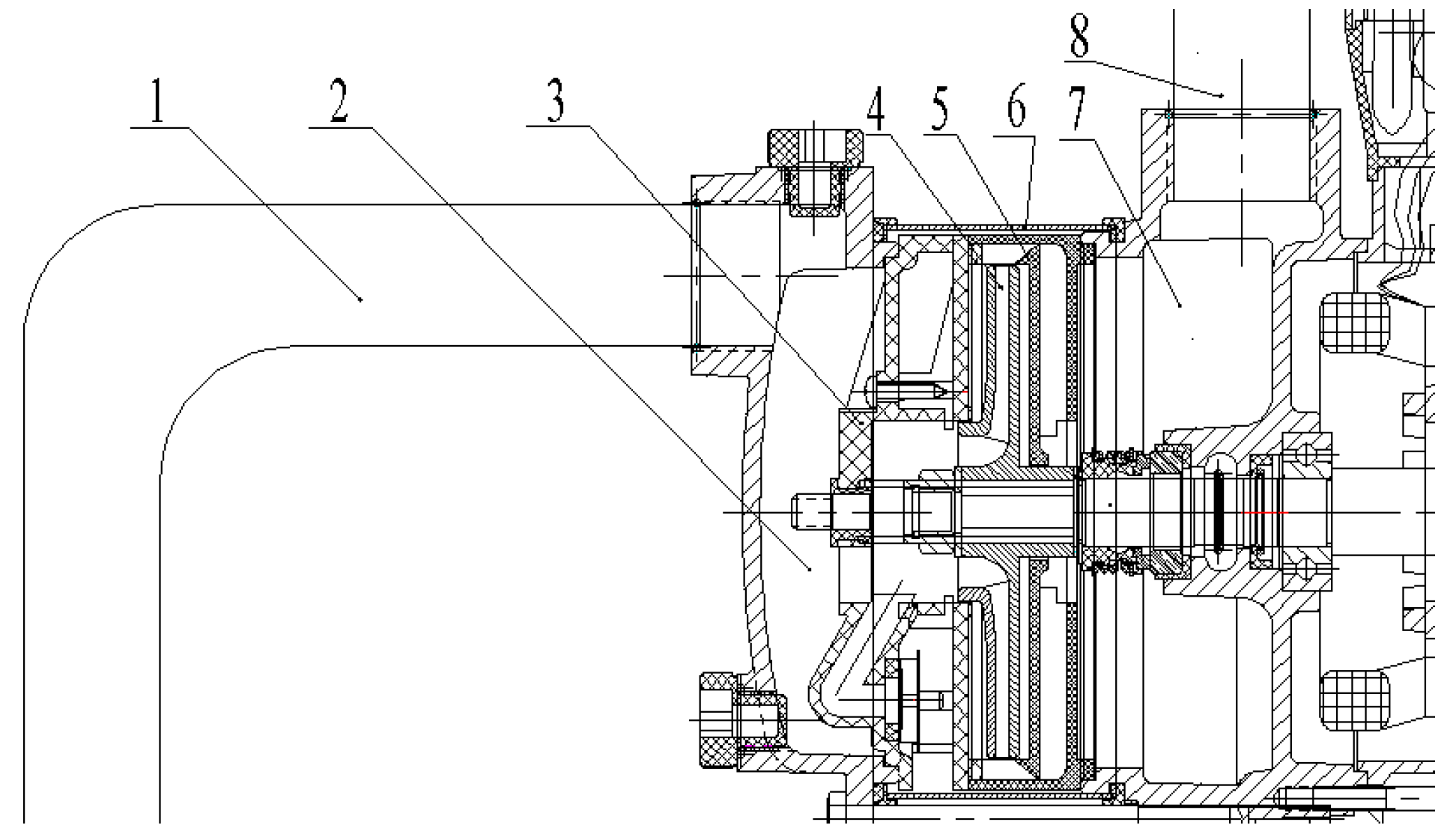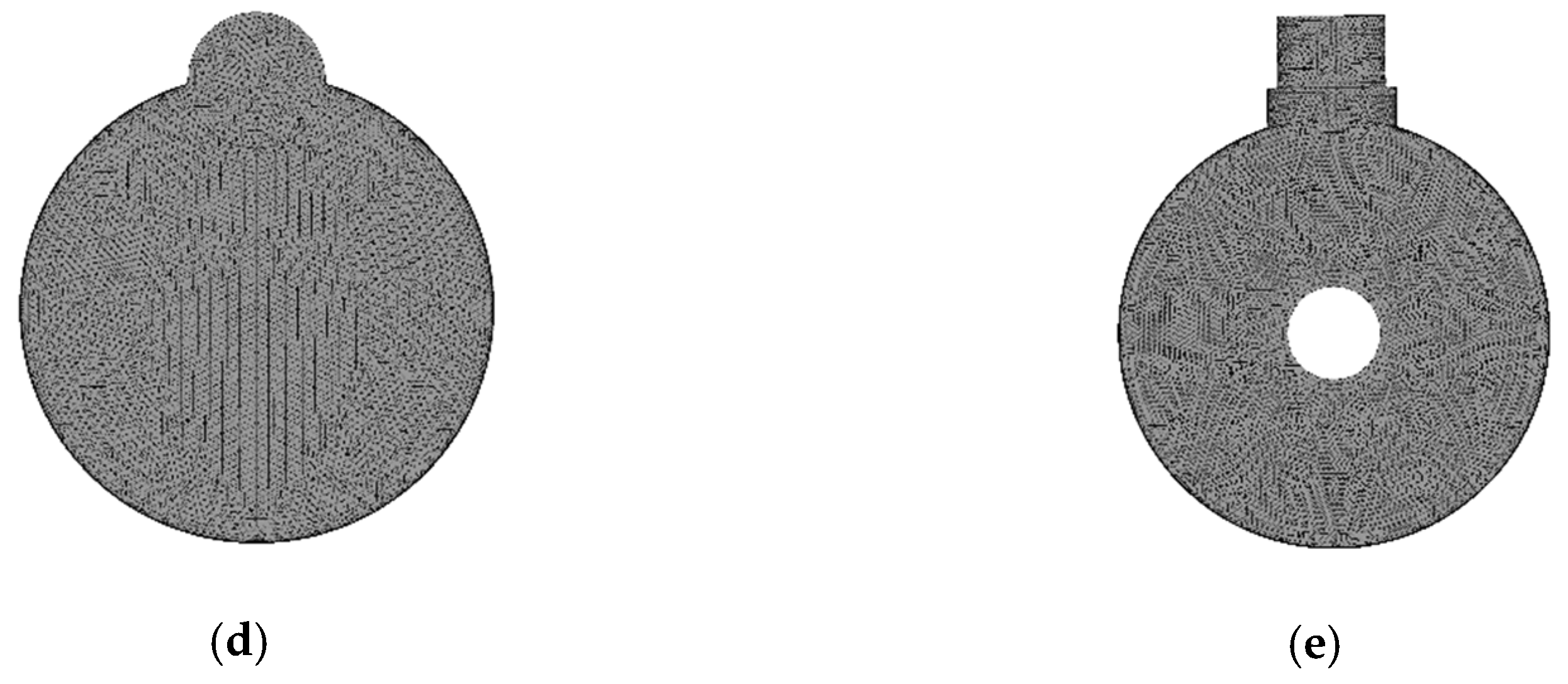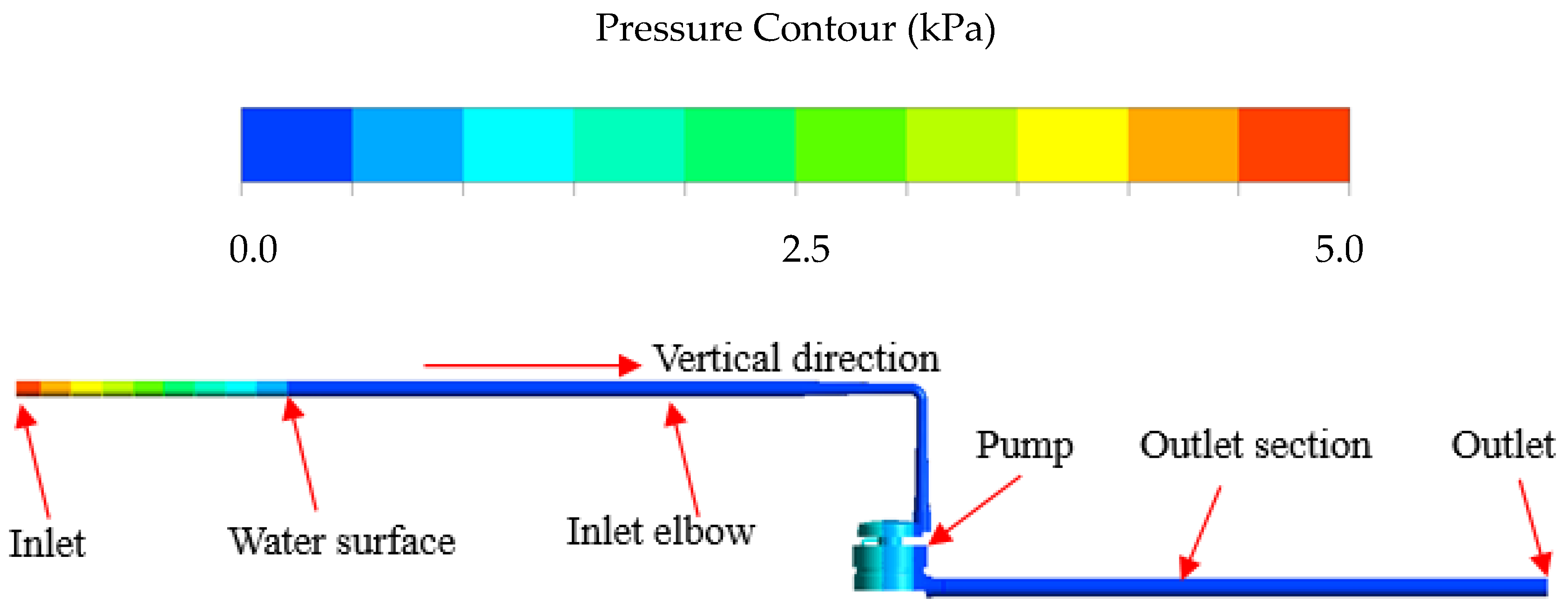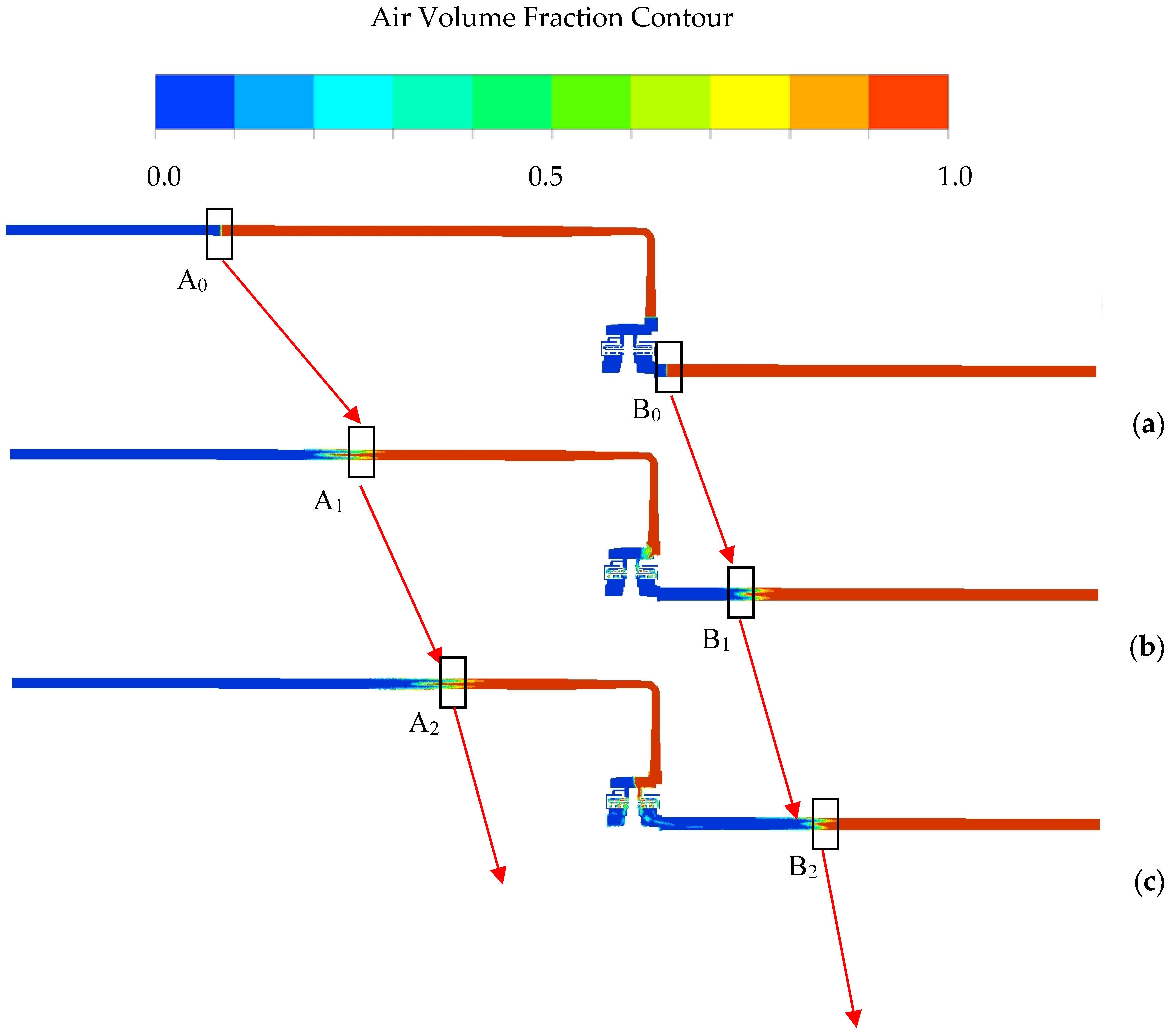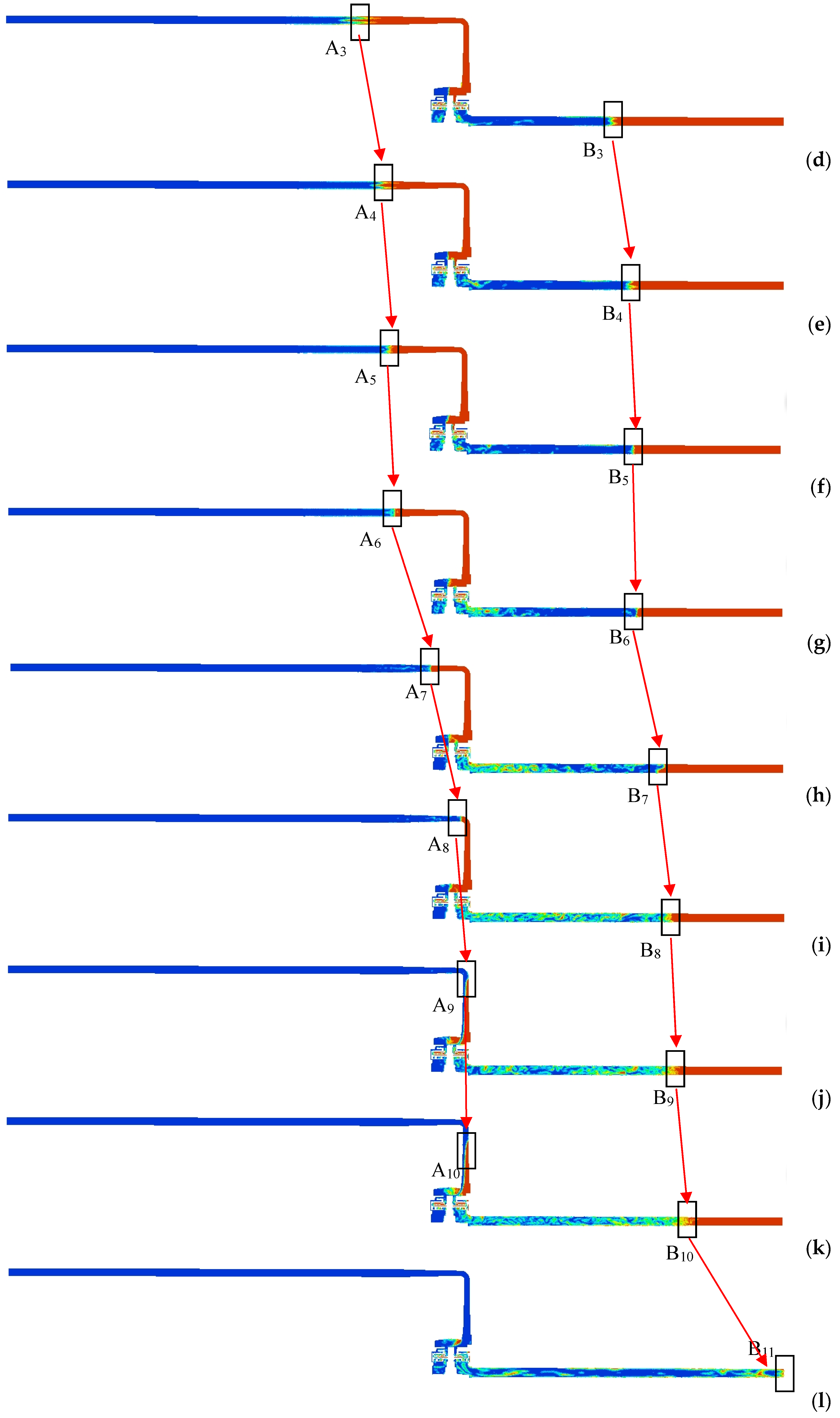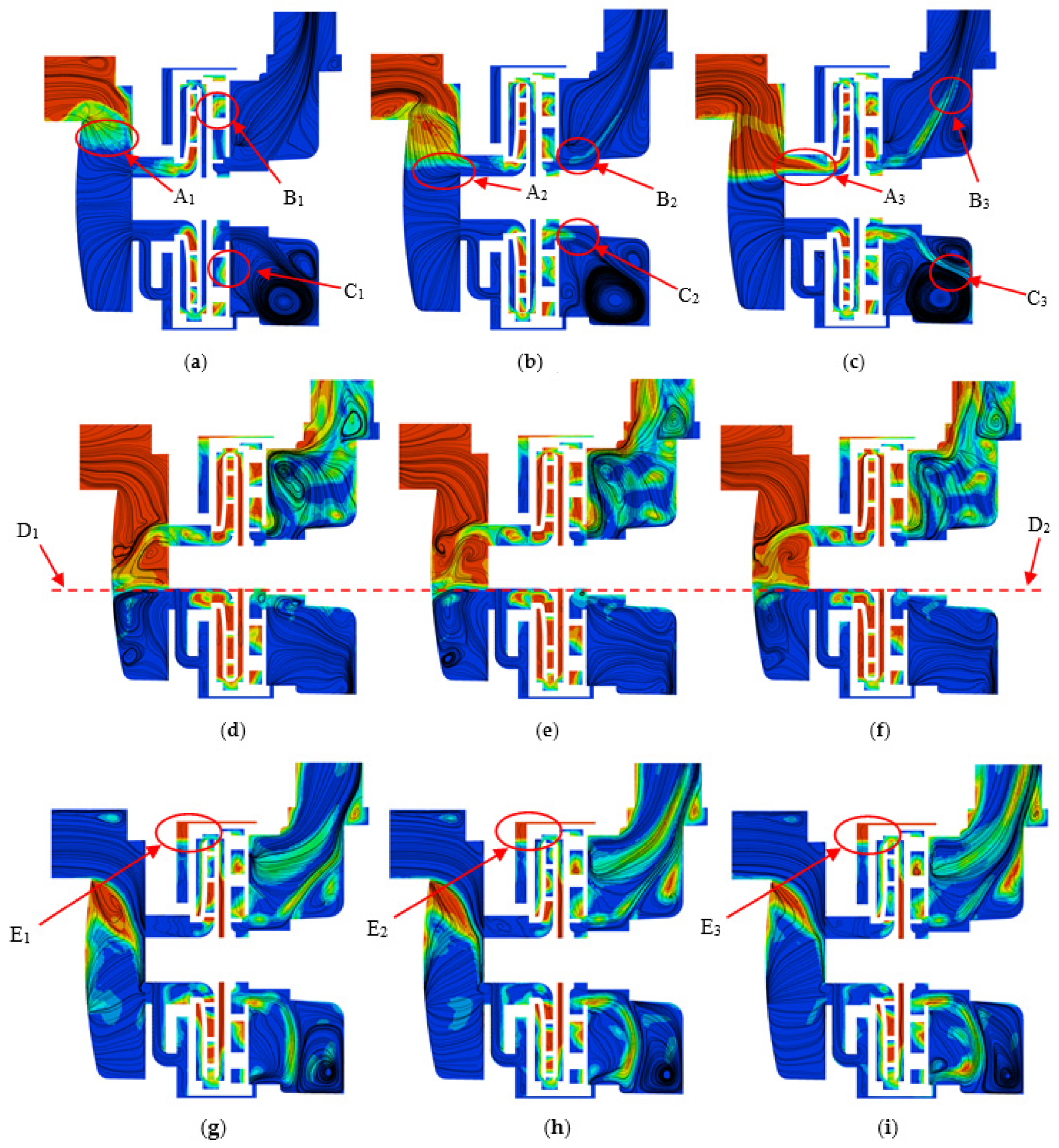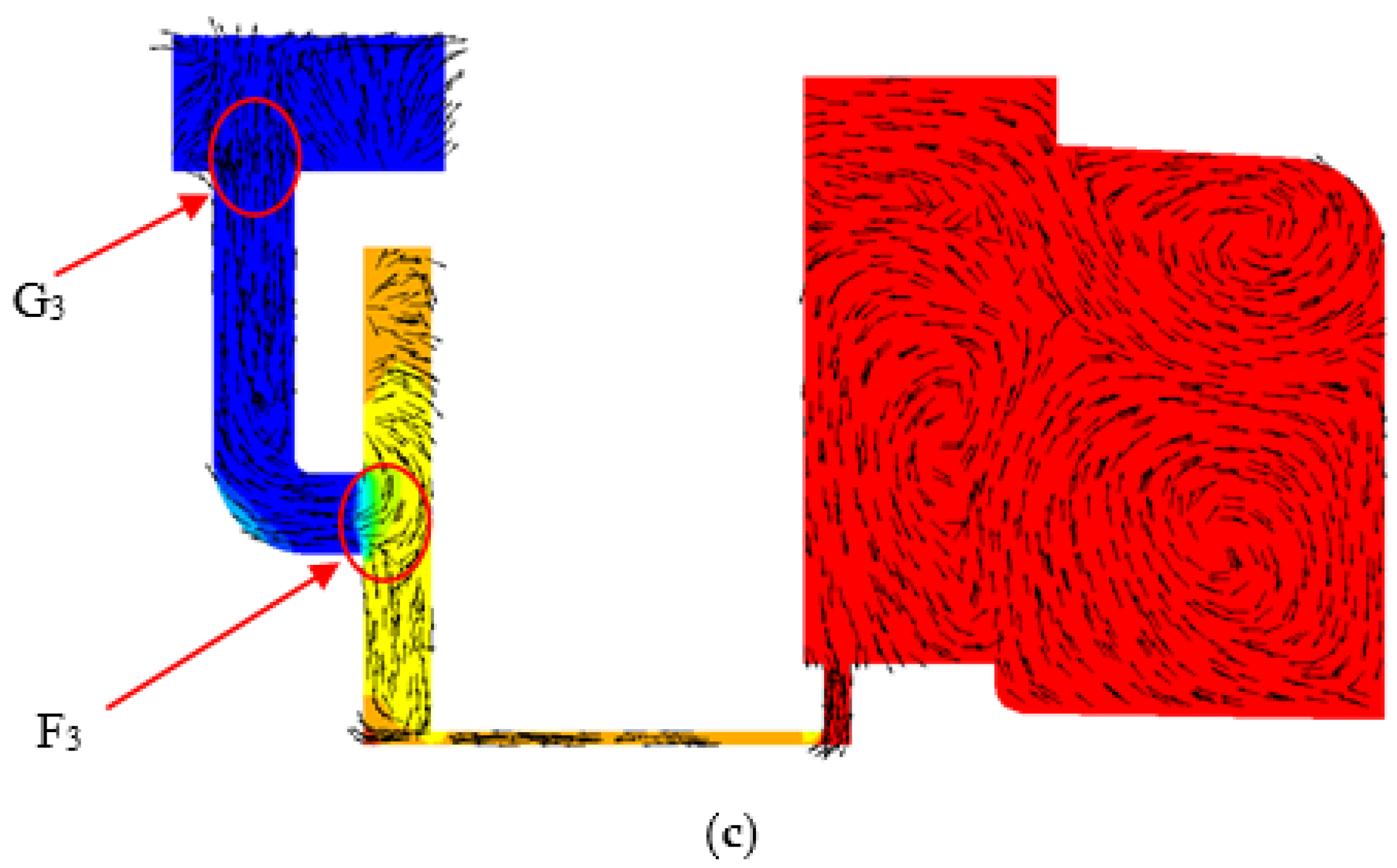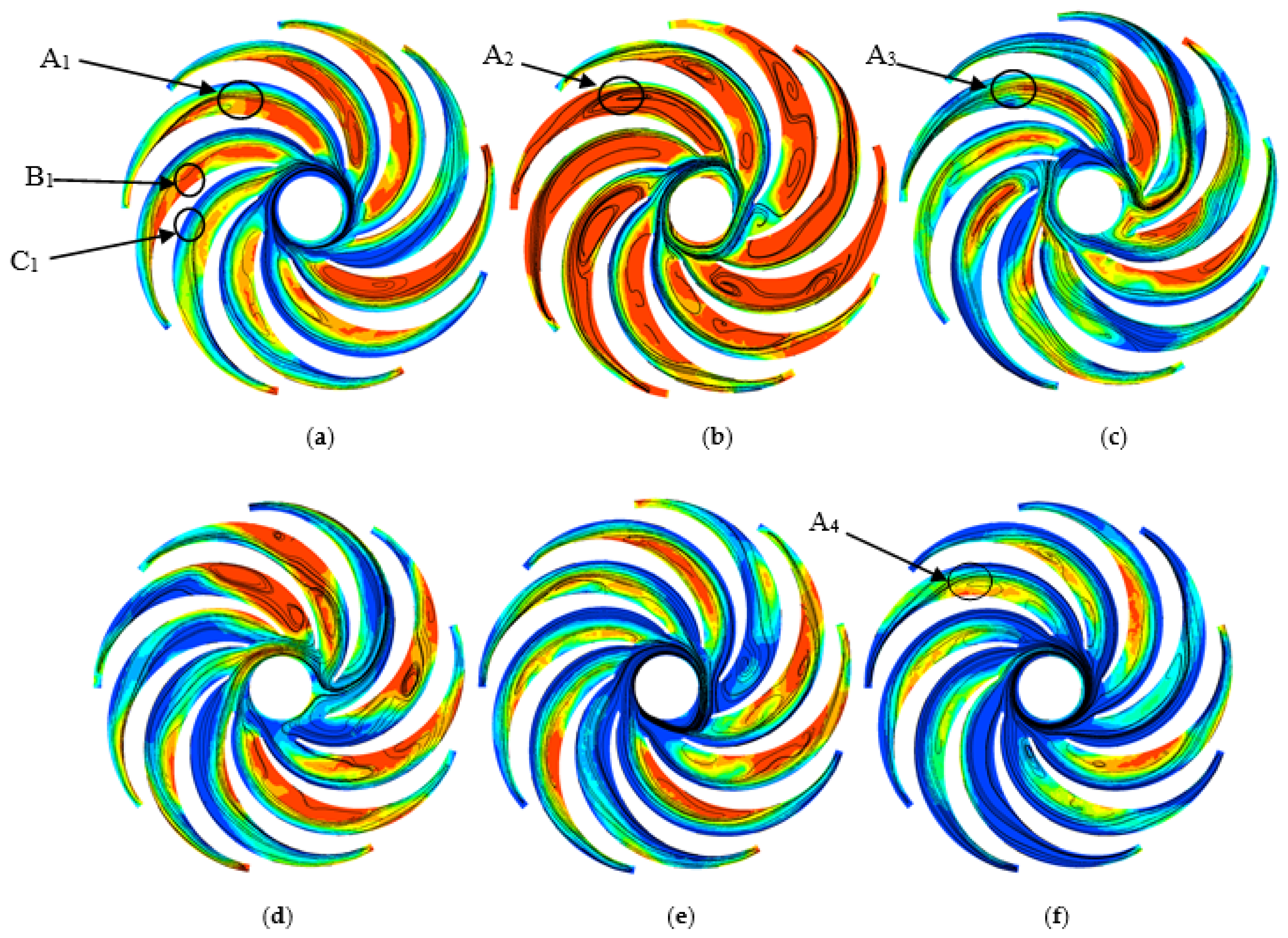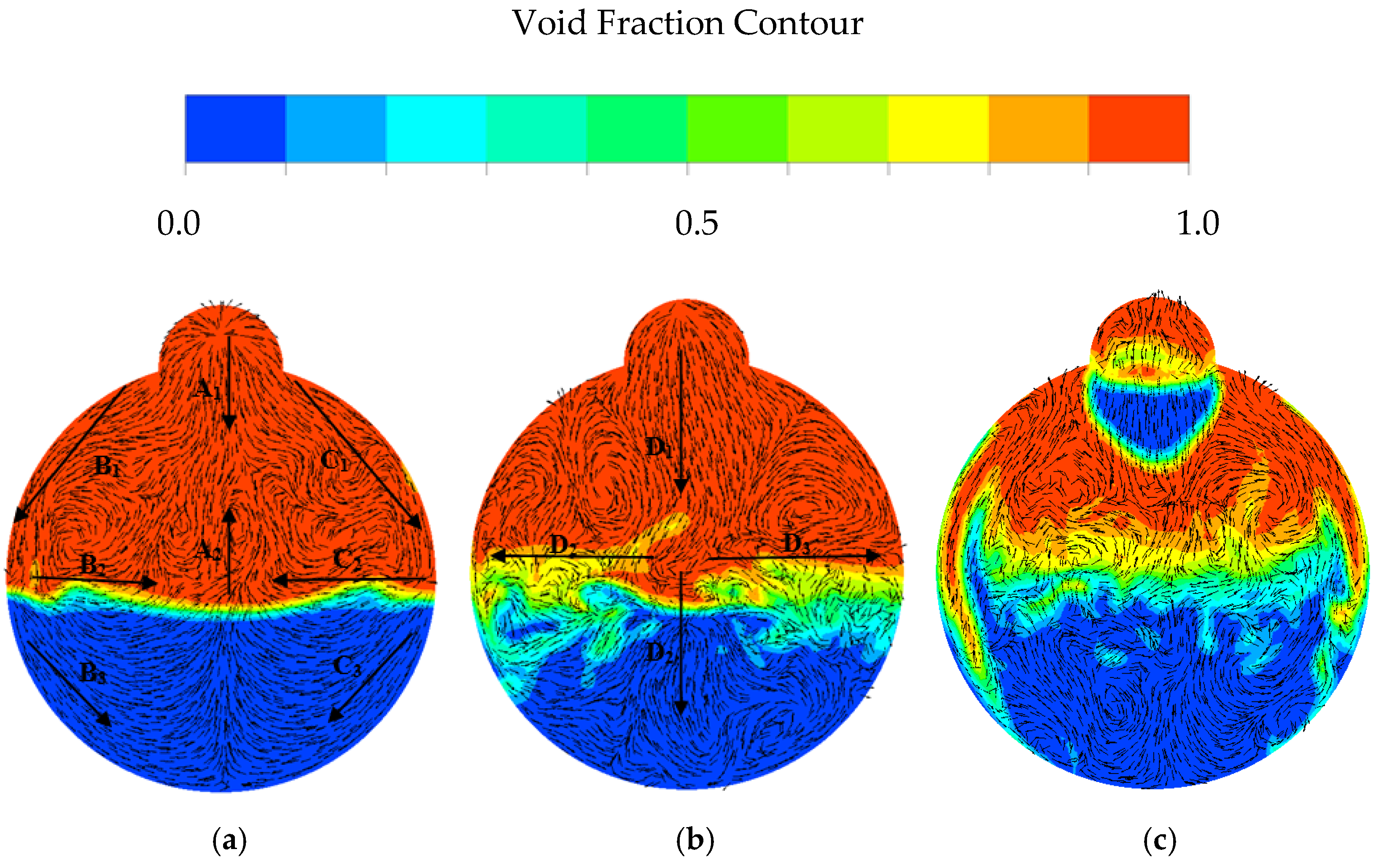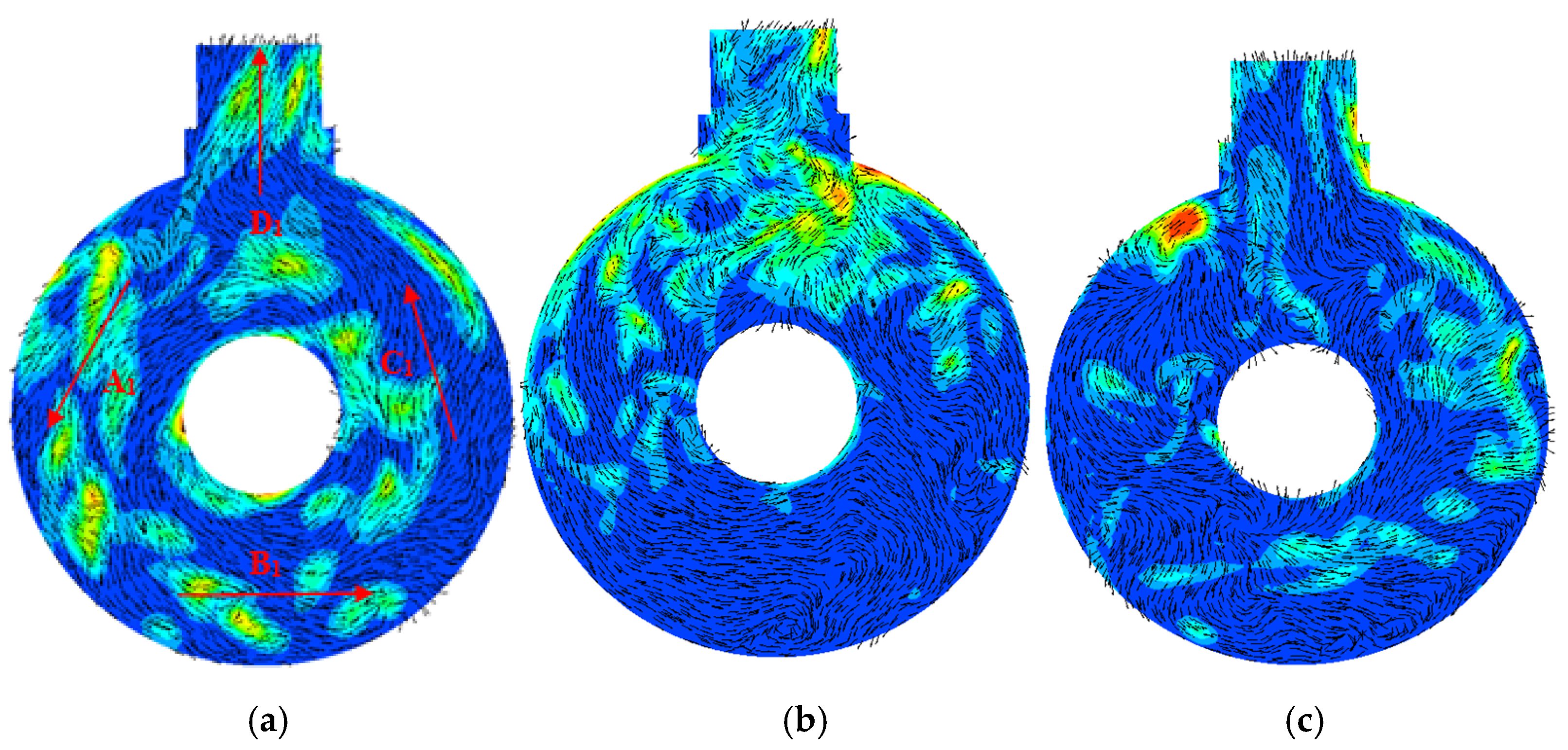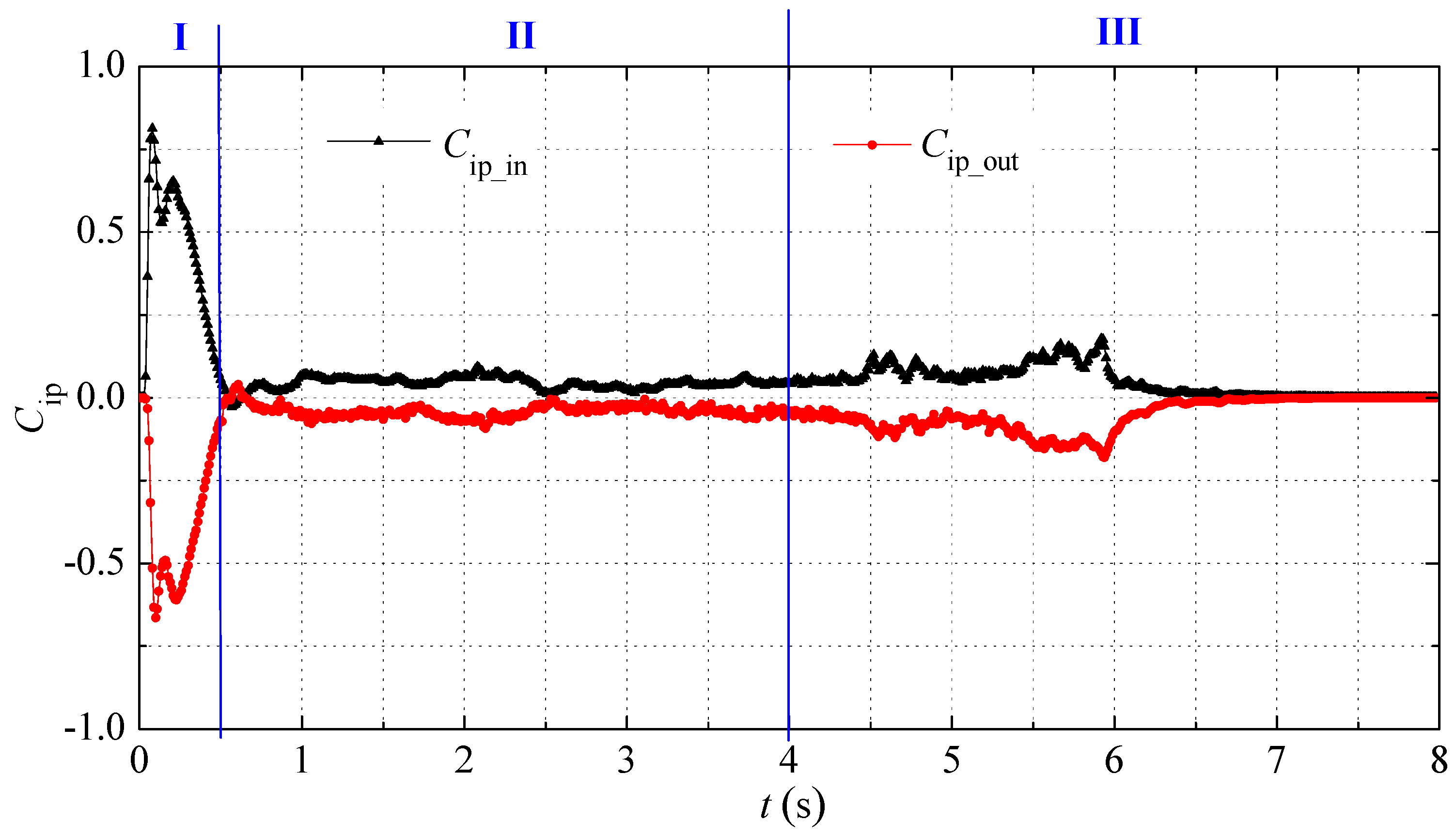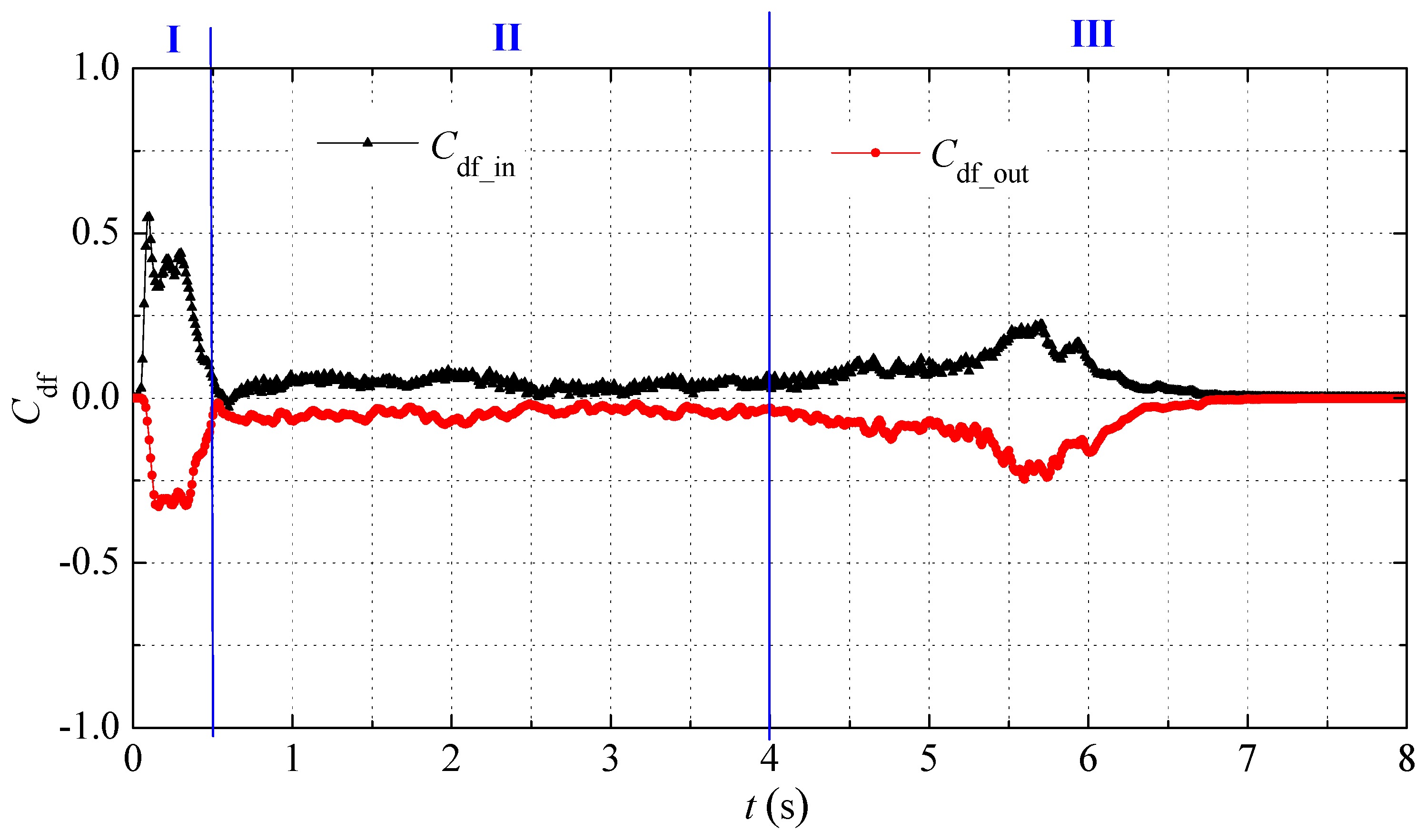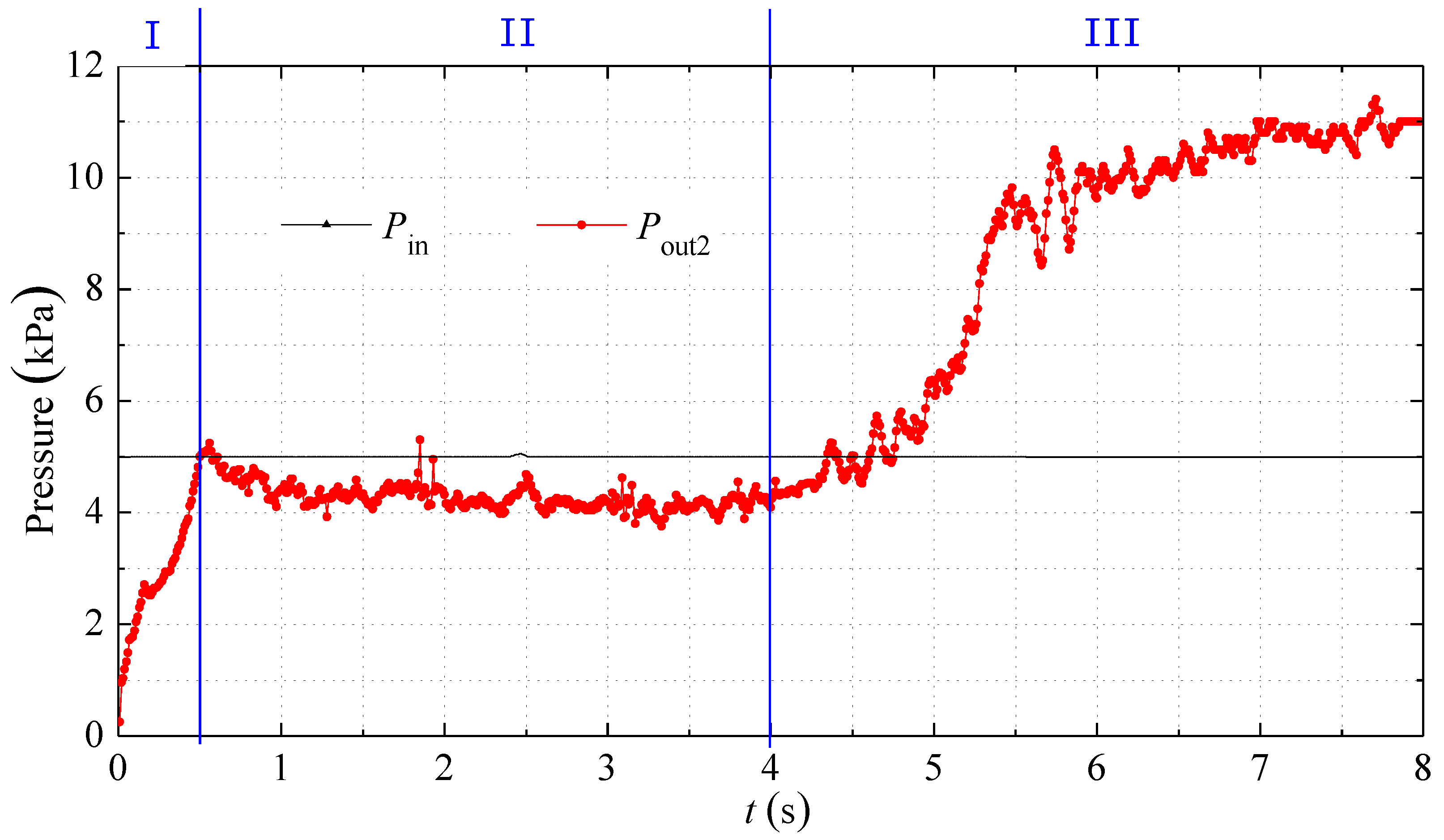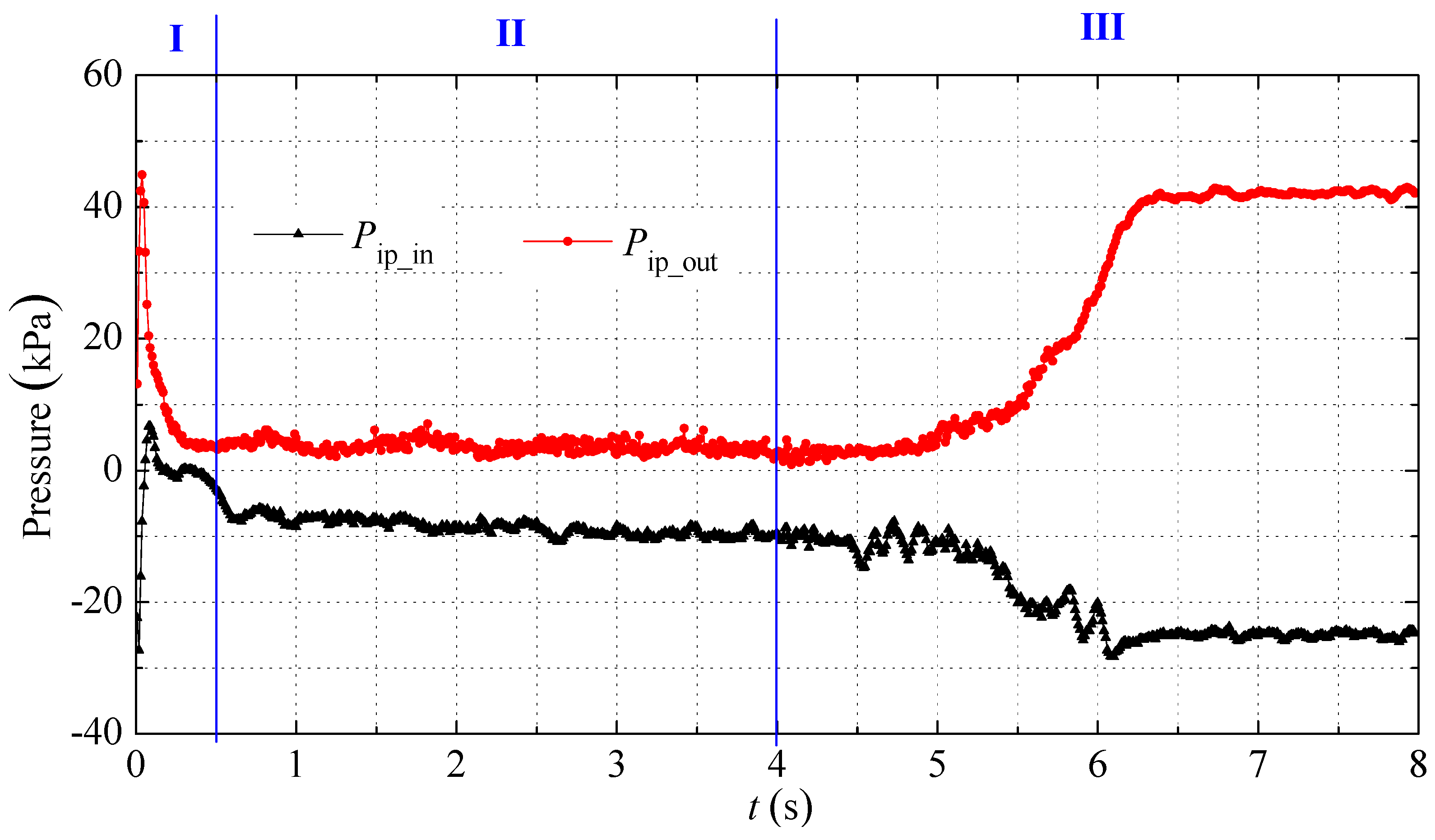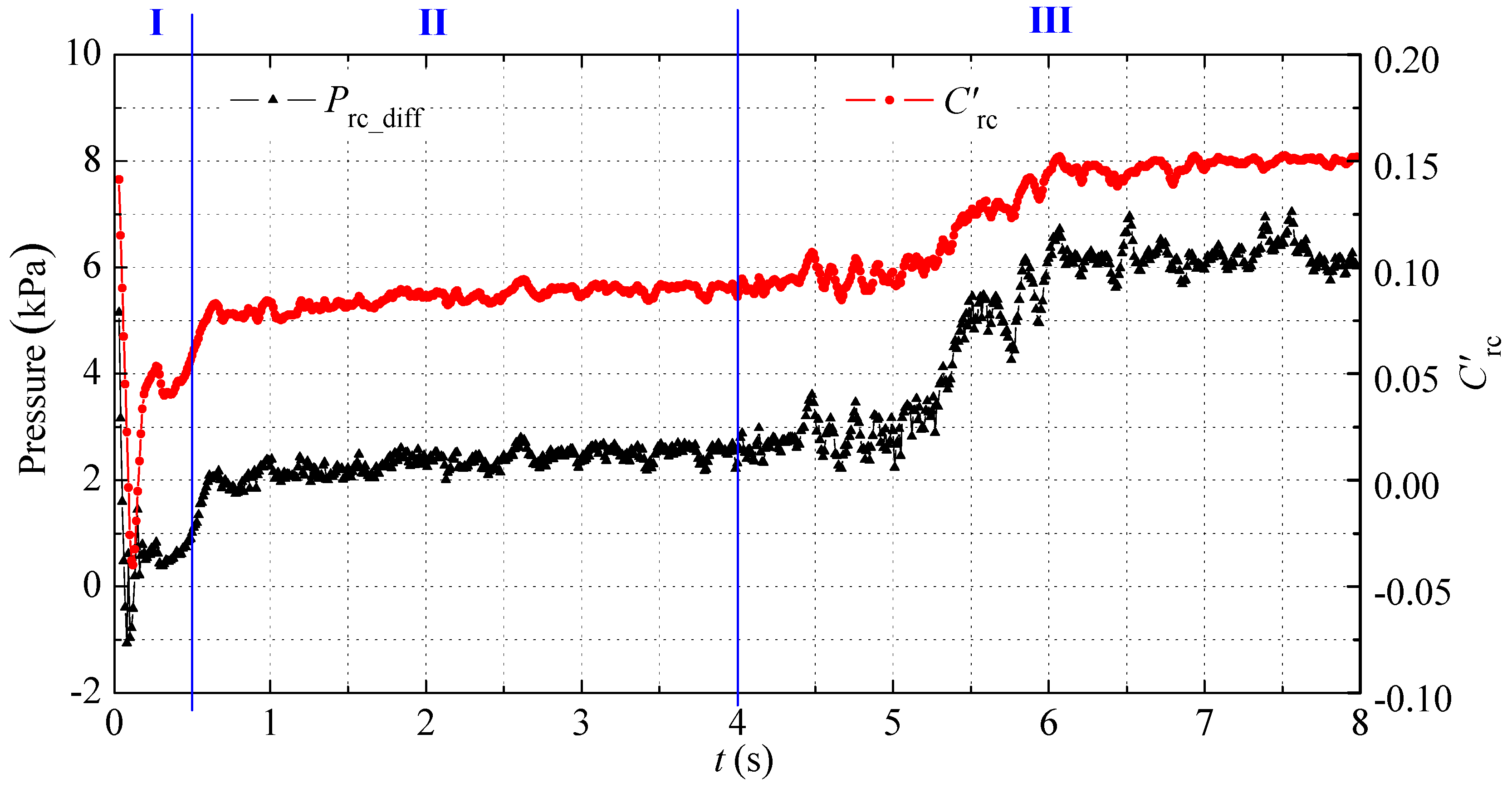3.1. Gas-Water Two-Phase Distribution in the Inlet and Outlet Sections of the Pump
Figure 7 presents the gas-water two-phase distribution in the inlet and outlet sections of the pump at several moments of the entire self-priming process based on CFD. The red area represents gas, and the blue area represents water. a–f show the gas-water two-phase distribution at
t = 0, 0.1, 0.2, 0.3, 0.4 and 0.5 s after the start of the pump. Due to the rotation of the impeller, the water in the pump flows rapidly to the outlet section, and the gas in the inlet section rapidly rushes to the pump, and the water column in the inlet and outlet sections rises continuously. Since the void fraction of the impeller is getting larger and larger, the work capacity of the impeller is gradually weakened, resulting in a slower rise in the water column in the inlet and outlet sections (see A
0 to A
5 and B
0 to B
5). At
t = 0.5 s, the height of the water column in the inlet and outlet sections remains essentially constant (see A
4 to A
5 and B
4 to B
5). At this time, the self-priming process due to the impeller rotational role is substantially complete. Moreover, the gas in the inlet section begins to enter into the outlet section at
t = 0.2 s.
Figure 7g–j show the gas-water two-phase distribution at
t = 1, 2, 3, 4 s after the self-priming pump is started. It can be seen that the water column in the inlet section is rising and close to the gas-water mixture cavity (see A
7 to A
10). That’s because some gas-water mixture in the gas-water mixture cavity enters into the gas-water separation cavity successively through the impeller and diffuser. In the gas-water separation cavity, the gas-water mixture is in a free-projecting state. Under the action of buoyancy, the lighter gas flows upwardly into the outlet section, and the heavier water flows downward, and flows back to the impeller inlet through the backflow channel for the next cycle. Repeatedly, the total amount of gas in the pump body steadily decreases, and the gas in the inlet section is continuously replenished to the inside of the pump, thereby causing the water column in the inlet section to continuously rise. Compared to the previous self-priming process, the rising rate of the water column in the current self-priming process is significantly smaller, mainly because the maximum self-priming rate in the previous self-priming process is approximately equal to the pump’s internal maximum flow rate, while the gas and the water are repeatedly mixed and separated, and the gas is exhausted a little bit in the current self-priming process. When 0.5 s <
t ≤ 2 s, the gas in the pump has not completely escaped from the water column in the outlet section. As the gas in the water column increases, the water column rises continuously (see B
5 to B
7). When 2 s <
t ≤ 4, the gas escapes from the water column of the outlet section. The current self-priming process is a gas-suction stage due to the role of gas-water mixture and gas-water separation.
Figure 7k–m shows the gas-water two-phase distribution at
t = 5, 6, 7 s. It can be seen that the water column in the inlet section rises continuously and enters the pump at
t > 4 s, so the impeller void fraction decreases continuously and the work capacity of the impeller is enhanced, leading to a continuous rise in the water column in the outlet sections (see B
9 to B
11). Compared with the previous self-priming process, the exhaustion rate of the gas in the current self-priming process is significantly larger and most of the gas in the pump is exhausted in a short time. Finally, the entire self-priming process ends and the self-priming centrifugal pump enters the normal working condition.
3.2. Streamline and Gas–Water Two-Phase Distribution in the Middle Section of the Pump
From the previous analysis, it can be found that the whole self-priming process of the self-priming pump is divided into three stages: the gas-suction stage due to the impeller’s rotating role in the initial self-priming stage, gas-suction stage due to gas-water mixing and the role of gas–water separation in the middle self-priming stage, and gas-suction stage due to the water flowing from the inlet elbow into the pump in the final self-priming stage.
In order to comprehensively study the gas-liquid flow of the pump in the self-priming process, the middle section of the entire pump that best reflects the flow characteristics was selected.
Figure 8 shows the streamline and gas-water two-phase distribution in the middle section of the pump at several moments of the self-priming process. The following three self-priming stages of the multistage self-priming pump were obtained through numerical calculation: initial (
t ≤ 1 s), middle (1 s <
t < 5 s), and final (
t ≥ 5 s) self-priming stages. Three moments were selected for analysis for each self-priming process. As shown in
Figure 8a,b, the time that the impeller rotates for a cycle is about 0.02 s, and the rotating impeller worked on the water to make it flow quickly to the outlet pipe in the initial self-priming process. Hence, the gas in the inlet section entered the gas-water mixture cavity, mixed with the water, then continuously flowed through the impeller and diffuser (A
1, A
2, A
3). The upper part of the gas-water mixture from the diffuser flowed to the outlet pipe (B
1, B
2, B
3), and the lower part flowed to the lower side of the gas-water separation cavity (C
1, C
2, C
3).
Figure 8d–f shows the streamline and gas-water two-phase distribution in the middle section of the pump at
t = 2, 2.02 and 2.04 s. It can be seen that compared with the initial self-priming stage, the change of gas-water two-phase distribution in the middle self-priming is slow, and the gas-water two-phase boundary line in the pump is based on the uppermost end of the lower half of the impeller (D
1–D
2). The upper half part is mainly the gas phase, and the lower part is mainly the water phase, mainly because the amount of water flowing out from the impeller is basically the same as that from the backflow channel into the impeller, and the amount of exhausting gas is basically the same as the amount of inhaling gas, resulting in that the gas-water two-phase boundary is basically stable.
Figure 8g,i indicate that in the final self-priming stage, the entire pump was mainly full of water. A large amount of gas was exhausted from the pump within a short period. In addition, since the backflow channel is only in communication with the lower half of the self-priming cover, a small portion of the gas is sealed in the upper half of the backflow channel and a large resting bubble region is formed (E
1, E
2, E
3). The gas is finally exhausted and even a small amount of gas is not exhausted.
3.3. Vector and Pressure Distribution in the Middle Section of the Backflow Channel
The backflow channel is a key component for water circulation in the self-priming pump.
Figure 9 presents the vector and pressure distribution in the middle section of the pump in the three self-priming stages at
t = 0.2, 2, and 6 s. It can be seen that due to the work of the rotating impeller, the pressure on the right side of the backflow channel is higher than the left side (B
1 and F
1), so that the water in the gas-water separation cavity can flow back to the impeller inlet through the backflow channel. In the initial self-priming stage (
t = 0.2 s), the gas-water mixture flowing out of the diffuser enters the lower part of the gas-liquid separation cavity (A
1). The gas-water mixture presents three flow states. Firstly, the water in the gas-water mixture flows to the backflow hole by gravity (B
1). Secondly, the gas in the water in the gas-water mixture flow freely (C
1). Thirdly, because the backflow hole is located on the left side of the gas-liquid separation cavity and the backflow capacity of the backflow channel is limited, resulting in a large vortex region on the right side (D
1). In the middle self-priming stage (
t = 2 s), the flow region of the whole gas-liquid separation cavity is divided into two parts (E
1–E
2). In the lower region, the water flows down to the backflow hole, while in the upper region, the gas flows upward to the pump outlet. In the final self-priming stage (
t = 6 s), the pressure difference between the two sides of the backflow channel increases.
In the initial self-priming stage, the water flowing back from the backflow channel is diverted at the intersection of the self-priming cover (F1). Some water flows to the impeller inlet (G1) and the remainder flows to the upper side of the self-priming cover. In the middle and final self-priming stages, as the water column in the inlet section rises and the pressure at the impeller inlet decreases (G1, G2, G3), the pressure difference between point F and point G rises continuously. The water flowing back from the backflow channel merges with the water on the upper side of the self-priming cover at point F, and flows to the inlet of the impeller. The above results show fully that the backflow capacity of the self-priming pump is gradually enhanced in the three self-priming stages.
3.4. Streamline and Gas-Water Two-Phase Distribution in the Middle Section of the Impeller and Diffuser
The impeller and diffuser are the core components of the pump. A radial diffuser with outward and return vanes was used, and the middle section of the impeller coincided with the middle section of the outward diffuser.
Figure 10 presents the streamline and gas–water two-phase distribution in the middle section of the impeller and outward diffuser in the three self-priming stages. As shown in
Figure 10a,b, the void fraction of the impeller and outward diffuser increased rapidly in the initial self-priming stage. When
t = 0.2 s, most of the space of the first-stage impeller was filled with gas. That is, only a small amount of gas–water mixture was present at the inlet and pressure surface of the impeller blade (A
1 and B
1), whereas plenty of gas existed near the suction surface of the impeller that had a large number of vortices, similar to a type of “dead water zone” (D
1). The gas-water mixture from the impeller inlet flowed along the pressure surface to the impeller outlet. Upon entering the outward diffuser, the velocity of the gas–water mixture decreased, so more water existed at the impeller outlet and outward diffuser (C
1). When
t = 0.4 s, the void fraction of the impeller and outward diffuser is further reduced, and the region containing the gas-water mixture at the inlet and pressure surface of the impeller blade is significantly decreased (A
1 and A
2). As shown in
Figure 10c,d, in the middle self-priming stage, most of the space in the impeller was filled with gas, and a small amount of water was present at the inlet and pressure side of the impeller blade. Eventually, the exhausting and inhaling rates gradually reached a state of dynamic equilibrium, and the void fraction of the impeller and outward diffuser is basically stable. Compared with the initial self-priming stage, and the vortex region in the impeller is slightly reduced in the middle self-priming stage (D
1 and D
2). As shown in
Figure 10f,g, the water in the inlet section has begun to enter the impeller in the final self-priming stage, and the void fraction of the impeller is drastically reduced. When
t = 6 s, the impeller is basically filled with water; however, there is still some gas in some flow channels of the impeller, indicating that the exhausting process of the impeller has unsteady characteristics. In summary, the key to the self-priming of the pump is that the rotating impeller forces a small amount of gas-water mixture at the impeller inlet to flow along the blade pressure surface to the impeller outlet and into the outward diffuser.
The return diffuser is an important component of the diffuser. It not only introduces the liquid into the outlet section, but also eliminates the rotational component of the liquid.
Figure 11 presents the flow line and gas-water two-phase distribution in the middle section of the return diffuser in the three self-priming stages. As shown in
Figure 11a,b the void fraction of the return diffuser increases sharply (A
1 and A
2) in the initial self-priming stage, and the return diffuser is substantially filled with gas at
t = 0.4 s, and there are many vortices in the gas region. As can be seen from
Figure 11c,d, compared with the initial self-priming stage, the void fraction of the return diffuser is decreased (A
3). As shown in
Figure 11e,f, a large amount of water enters the return diffuser in the final self-priming stage, and the void fraction of the return diffuser is further decreased (A
4). In general, the streamline and gas-water mixture in the return diffuser do not evenly distributed along the circumference. The gas first gathers in the region close to the suction surface of the return diffuser (B
1), while the water first gathers near the pressure surface (see C
1), and the gas-liquid mixture from the outward diffuser flows along the pressure surface of the return diffuser, which is consistent with the gas-water two-phase distribution in the impeller.
3.5. Vector and Gas-Water Two-Phase Distribution in the Middle Section of the Gas-Water Mixture and Separation Cavities
As an important part of the self-priming pump, the gas-water mixture cavity mainly provides space to promote the mixing of gas and water.
Figure 12 shows the vector and gas-water two-phase distribution of the gas-water mixture cavity in the self-priming process. As shown in
Figure 12a, there is a clear boundary layer in the gas-water mixture cavity in the initial self-priming stage, and the gas is in the upper layer, while the water is in the lower layer. Moreover, when
t = 0.4 s, a large amount of gas from the inlet section enter the gas-water mixture cavity and flows downward in three directions (A
1, B
1 and C
1). The gas in the middle direction flows directly downward, the gas in the left and right directions flows down the wall of the gas-liquid mixture cavity, and some of the gas flows back along the boundary layer to the middle portion of the gas-water mixture cavity (B
2 and C
2), and finally merges with the inflowing gas in the middle direction (A
2), and the other gas is mixed with water at the boundary layer to enter the water region (B
3 and C
3). As can be seen from
Figure 12b, the gas-water boundary layer becomes unclear in the middle self-priming stage. The gas from the inlet section enter the gas-water mixture cavity in the middle direction (D
1), one part is mixed with water at the boundary layer to enter the water region (D
2), and the other part is refluxed in the left and right direction (D
3 and D
4), forming a large number of vortices. Since the inhaling rate of the gas in the middle self-priming stage is much smaller than that in the initial stage, three parts of gas are combined in the middle of the gas-water mixture cavity in the initial self-priming stage, while a strand of gas is divided into three parts in the middle self-priming stage. As shown in
Figure 12c, the gas-water boundary layer has disappeared in the final self-priming stage. Compared with the water region, the flow field in the gas region is more disordered, indicating that the vortex is more likely to be generated in the gas region.
The gas-water separation cavity mainly provides space to promote the separation of gas-water mixture.
Figure 13 illustrates the vector and gas-water two-phase distribution of the gas-water separation cavity in the self-priming process. As shown in
Figure 13a, the void fraction of the gas-water separation cavity is not high overall and exhibits a non-uniform distribution in the initial self-priming stage. Under the influence of the rotation of the impeller, the gas-water mixture rotates counterclockwise in the annular cavity and escapes from the separation cavity, which is consistent with the rotating direction of the impeller (A
1, B
1, C
1 and D
1). As can be seen from
Figure 13b, the gas-liquid separation cavity plays the role of the separation of gas and water in the middle self-priming stage. The gas is basically distributed in the upper half of the gas-water separation cavity due to the influence of gravity. Although the internal flow field of the entire gas-water separation cavity is disordered, the flow direction of the annular cavity is counterclockwise. As shown in
Figure 13c, since the water from the inlet section starts to enter the pump, a large amount of gas-water mixture flows in the gas-water separation cavity, which not only causes a decrease in the void fraction, but also causes the gas to spread throughout the gas-water separation cavity.
3.6. Data Analysis of the Self-Priming Pump Based on CFD
In the self-priming process of a self-priming centrifugal pump, the gas in the section is exhausted to the outlet pipe through the operation of the pump. In
Figure 14, the inlet surface of the inlet section is defined as “In”; the inlet surface of the gas-liquid mixing cavity is defined as “In2” and the outlet surface of the gas-liquid separation cavity is defined as “Out2”. The outlet surface of the outlet pipe is defined as “Out”. In order to illustrate the self-priming capability of the pump, the gas volume coefficient, gas flow coefficient, water flow coefficient, impeller void fraction, and diffuser void fraction are defined in Formulae (2) to (4), respectively.
where
CV is the gas volume coefficient in the pump;
Vg is the sum of the internal gas volume of the pump’s components, except for the outlet pipe, in m
3;
Vg is the gas volume in the pump in the initial state, which is equal to the gas volume in the inlet section, in m
3;
C is the gas flow coefficient in the pump;
C’ is the water flow coefficient in the pump;
Qg is the gas flow in the self-priming process in m
3/h;
Qw is the water flow in the self-priming process in m
3/h;
Qd is the water flow at the rated condition after the pump operates normally in m
3/h.
Figure 15 shows the gas volume coefficient
CV and the gas flow coefficient
Cout2 on the “Out2” surface during the self-priming process. A negative gas flow coefficient means that the gas flows out of the pump, whereas a positive one indicates that the gas flows into the pump. In accordance with the previous analysis, the self-priming process of the pump was divided into three stages as follows: initial (
t ≤ 0.5 s), middle (0.5 s <
t < 4 s), and final (4 s ≤
t). These self-priming stages are shown as I, II, and III in
Figure 14. When 0 s <
t ≤ 0.15 s, the amplitude of
Cout2 was close to 0, and the value of
CV remained 1, indicating that the gas in the inlet section began to reach the “Out2” surface at
t = 0.15 s. When
t > 0.15 s, the distribution of
Cout2 showed a serious fluctuation, which shows the unsteady characteristics of the self-priming process of the pump. When 0.15 s <
t ≤ 0.5 s, the amplitude of
Cout2 increased initially then decreased; afterward, it reached the maximum of 0.15. When 0.5 s <
t ≤ 4 s, it decreased and reached the minimum of 0.02. When 4 s <
t ≤ 5.8 s, it increases again, reaching the maximum of 0.56. When 5.8 s <
t ≤ 8 s, it decreases again and finally approached 0, indicating that the gas in the pump was basically exhausted. In the entire self-priming process, the value of
CV continuously decreased, and the decrement rate was affected by
Cout2.
The impeller and diffuser are the core components of the self-priming pump.
Figure 16 displays the gas flow coefficient
Cip_in and
Cip_out of impeller inlet and outlet in the self-priming process. When 0 s <
t ≤ 0.05 s, the value of
Cip_in increased from 0 to 0.8, while that of
Cip_out increased from 0 to 0.65, indicating that part of the gas remained in the impeller. When 0.08 s <
t ≤ 0.5 s, the working capacity of the impeller was weakened due to the increase of the impeller void fraction in the initial self-priming stage, and the amplitudes of
Cip_in and
Cip_out decreased and approached 0, showing a certain positive correlation between them. When 0.5 s <
t ≤ 4 s, the amplitudes of
Cip_in and
Cip_out fluctuated continuously but increased first and then decreased on the whole. The reason for the increment was that the amplitudes of
Cip_in and
Cip_out were close to 0 at
t = 0.5 s, while the reason for the decrement was that the lower the pressure at the impeller inlet, the slower the rising rate of the water column in the inlet section, and the slower the suction rate of the impeller. When
t > 4 s, the water in the inlet section flowed into the impeller in the final self-priming stage, causing the drainage capacity of the impeller to increase sharply. The amplitudes of
Cip_in and
Cip_out continued to increase, and the maximum value was close to 0.2. Then, as the total amount of gas in the pump decreased, the amplitudes of
Cip_in and
Cip_out continued to decrease, and finally close to 0.
Figure 17 shows the gas flow coefficient
Cdf_in and
Cdf_out of the diffuser inlet and outlet in the self-priming process. It can be seen that the changing law of
Cdf_in and
Cdf_out was basically the same as that of
Cip_in and
Cip_out. In the initial, middle, and final self-priming stages, the value of
Cdf_in and
Cdf_out first increased and then decreased.
As a standard characteristic parameter of the pump, pressure is one of the important factors affecting the self-priming capability of the self-priming centrifugal pump.
Figure 18 presents the pressure
Pin on the “In” surface and pressure
Pout2 on the “Out2” surface in the self-priming process. It can be seen that the value of
Pin was basically kept at 5 kPa, due to that the “In” surface was 0.5 m under water and the pressure value was only affected by atmospheric pressure. In addition, the value of
Pout2 was rapidly increased from 0 kPa to 5 kPa in the initial self-priming stage, it remained stable in the middle self-priming stage, and rapidly increased to 10 kPa in the final self-priming stage.
Figure 19 illustrates the pressure
Pip_in and
Pip_out of the impeller inlet and outlet in the self-priming process. It can be seen that when 0 s <
t ≤ 0.05 s, after the impeller filled with water started to rotate, the value of
Pip_in rapidly decreased from 0 kPa to −27 kPa and then increased to 7 kPa, while the value of
Pip_out increased to 45 kPa. When 0.05 s <
t ≤ 0.5 s, with the rapid increase of the impeller void fraction, the working capability of the impeller was sharply weakened, the value of
Pip_in and
Pip_out decreased to −2.5 kPa and 3.5 kPa, respectively. When 0.5 s <
t ≤ 4 s, since the gas in the inlet section was slowly exhausted out of the pump, the water column in the inlet section raised continuously, and the value of
Pip_in showed a downward trend, while the value of
Pip_out was basically stable. When 4 s <
t ≤ 8 s, the value of
Pip_in dropped sharply and the value of
Pip_out raised significantly due to the sharp decrease of the impeller void fraction. Finally, when the impeller void fraction was close to 0, the value of
Pip_in and
Pip_out remained at −25 kPa and 42 kPa.
Figure 20 and
Figure 21 present the pressure difference between the two ends of backflow channel
Pbc and water flow coefficient
C’bc in the whole self-priming process and middle self-priming stage. It can be seen that in the initial self-priming stage, the value of
Pbc and
C’bc reached the maximum rapidly, then decreases rapidly. In the middle self-priming stage, the value of
Pbc and
C’bc constantly fluctuated. In the final self-priming stage, the values of
Pbc and
C’bc increased sharply and remained essentially stable. Moreover, the value of
C’bc had a positive correlation with
Pbc, which was especially evident in the middle self-priming stage, as shown in
Figure 20. In the middle self-priming stage of
t = 2.65 s, the maximum value of
Pbc reached 2.8 kPa, while the maximum value of
C’bc was 0.095.
